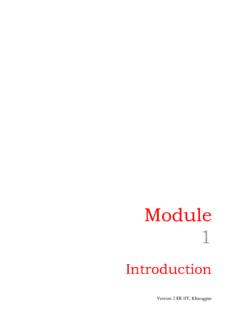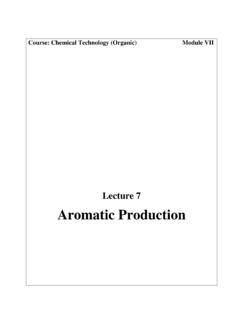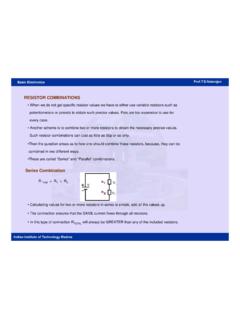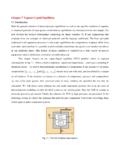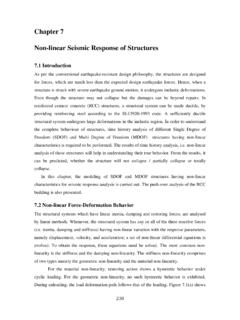Transcription of Module 8 : Surface Chemistry Lecture 37 : Surface …
1 Module 8 : Surface ChemistryLecture 37 : Surface characterization Techniques Objectives After studying this Lecture , you will be able to do the following:Use the Langmuir s isotherm to calculate the Surface area of the BET (after Brunauer, Emmett and Teller) equation is used to give specific Surface area from X-Ray Photoelectron Spectroscopy (XPS), Auger Electron Spectroscopy (AES) and Low Energy ElectronDiffraction(LEED) to characterize Surface microscopic methods of characterization such as Scanning Electron Microscopy (SEM) and Scanning Tunneling Microscopy (STM) to analyse Surface structures of Surface characteristics of a material refer to the properties associated with its Surface . Typically measurementsof Surface area, Surface roughness, pore size, and reflectivity constitute Surface characteristics. Information onsurface characteristics is very important for the possible applications of surfaces as semiconductors,heterogeneous catalysts and also in biological research.
2 Surface area is an attribute that is used by catalystmanufacturers and users to monitor the activity and stability of a catalyst. There are different methods used tomeasure different Surface properties. Most methods are based on the isothermal adsorption of nitrogen. Manyadvances in Surface science have made the methods Surface sensitive, , they are sensitive to the outermostatomic layers (depth of 2-3 atomic layers) of the bulk solids. These techniques could be classified into twocategories: Classical Methods and Instrumental Methods: (a) Langmuir s model: In adsorption systems where Langmuir s model is followed, the maximum amount of adsorbate adsorbed pergram of adsorbent for the formation of monolayer, Xm/(mg/g), is determined. Knowing the approximate contactarea of an adsorbate molecule, Surface area of adsorbent could be calculated using following equation: Surface area of the adsorbent (m2/g) = ( ) Here, Xm = Maximum amount of adsorbate adsorbed per gram of adsorbent for monolayer formation, M =Molecular weight of the adsorbate(mg/molecule), N = Avogadro s number and S = Contact Surface area by eachmolecules (m2).
3 Example : The volume of nitrogen gas at 1 atm and 273K required to cover 1g of the silica gel is Calculate the Surface area of the gel if each nitrogen molecule occupies an area of X 1020 m2 Solution:Number of moles of N2 in = = X 10-3 moles of N2 gasTherefore, total number of N2 molecules in dm3 of N2 = x 10-3 x x 1023 molecules dm3 = x 1020 The total area of 1g of the silica gel = x 1020 x x 10-20 m2 = Methods: (b) BET equationBET (after Brunauer, Emmett and Teller) equation is used to give specific Surface area from the adsorptiondata. The BET equation is used to give the volume of gas needed to form a monolayer on the Surface of thesample. The actual Surface area can be calculated from a knowledge of the size and the number of the adsorbed gas molecules.
4 Nitrogen is used most often to measure BET Surface , but if the Surface area is verylow, argon or krypton may be used as both give a more sensitive measurement, because of their lowersaturation vapor pressures at liquid nitrogen temperature. BET equation is as follows: ( ) Where, V = volume of gas adsorbed at pressure p; Vm = amount of gas corresponding to one monolayer; z = p/p*, ratio of pressure of gas and pressure at saturation; c = a plot of vs z gives slope and intercept at , and cVmono could be determined. Theresults can be combined to give c and Vmono. When the coefficient c is large, the isotherm takes the simpler form as follows. ( ) This is applicable to unreactive gases on polar surfaces , for their c is 102. Higher value of c will meanmainly monolayer formation. The value of Vmono, the volume of gas required to form monolayer, is ofconsiderable interest because it helps in the calculation of Surface area of a porous solid.
5 The Surface areaoccupied by a single molecule of adsorbate on the Surface can be calculated from the density of the liquefiedadsorbate. For example, the area occupied by a nitrogen molecule at -195o C estimated to be m2assuming molecules to be spherical and close packed in the liquid. Thus, from the value of Vmono obtained fromthe BET theory, Surface area of the adsorbent could be Methods: (b) BET equation Example : The data given below are for the adsorption of nitrogen on alumina at K. Show that they fit ina BET isotherm in the range of adsorption and find Vmono and hence Surface area of alumina (m2/g). At K,saturation pressure, P* = torr. The volumes are corrected to STP and refer to 1g of alumina. P/ (torr) V (cm3/g: STP) Solution: From the above data, we have 10 Z = 10(P/P*) x = 103Z/(1-Z) (V/cm3) From BET equation , A plot of z/(1-z) against z will give a straight line with intercept z = 0 as equal to and slope will be Intercept of the plot is 10-3 cm-3 where as slope = 10-2 cm-3 Intercept = = 10-3 cm-3 = 10-4 cm-3 Methods: (b) BET equation Example.
6 Slope = = 10-2 10-2 cm-3 = (C-1) = (C- 1) 10-4 cm-3(C- 1) = 10-2 / 10-4 = C = , = 10-4 cm-3 Vmono = 1 / C 10-4 cm-3 = 1/ 10-4 = cm3 = dm3 Number of N2 molecules = ( ) 1023 = 1020 molecules The total area = 1020 10-20 m2= m2/g (contact area of one N2 molecule = 10-20 m2 ) Now we shall consider the instrumental methods. These may be further classified as spectroscopic methodsand microscopic methods: These methods make use of the principle that when a beam of electrons or high-energy radiation (usually X-rays) are bombarded at the Surface , the Surface electrons from the upper layer of are ejected. These electronsare called secondary electrons. Since the energy of these electrons is very low, these are assumed to beproduced from only a few layers of the Surface .
7 Electrons of this energy (10-30 eV) cannot reach the surfacefrom underlying layers. In spectroscopic methods, surfaces are analyzed by capturing secondary electrons ofdifferent energies, which are characteristic of their environment. Based on spectroscopic theory some of thetechniques are discussed below.(a)X-Ray Photoelectron Spectroscopy (XPS): X-ray photoelectron spectroscopy (XPS) was developed in mid 1960 by K. Siegbohn and his colleagues. Lateron, K. Siegbohn was awarded Nobel Prize for physics in 1981 for the work on XPS. This technique provides awide range of information regarding atomic composition, oxidation states, and chemical structures. Because ofits versatility it is also called Electron Spectroscopy for Chemical Analysis (ESCA). Basic principle of thistechnique is based on phenomenon called photoelectric effect, rationalized by Albert Einstein in 1905. Whenphotons of known energy (usually X-rays) knock the Surface , an electron from K-shell is knocked out; kineticenergy of this electron is measured in the spectroscopy.
8 The spectrum is given as the binding energy asfunction of electron counting rate. Binding is one unique character of different elements. Binding energy of anatom can be calculated from the following equation. Figure Photoelectric Effect Binding Energy (eV), = h W( ) where, h = Incident energy, = Kinetic Energy of the ejected electron and W = Work function. In the XPS spectrum, the innermost orbital appears a at higher binding energy than the outer orbital. Bindingenergies of 1s orbitals increase with atomic methods of characterizationEven microscopic methods make use of more or less the same principles, but these methods are generated bybombarding the Surface with high-energy electrons, which are then multiplied several times so as to produce amagnified image of the Surface on the fluorescent methods like STM, AFM work based on quantum mechanical principles.
9 (a)Scanning Electron Microscope (SEM):This method takes advantage of the wave nature of light to attain higher magnification. It has nothing to dowith the electron microscopy principles, only the magnification is comparable. In SEM a beam of electrons isgenerated in vacuum which is collimated by electromagnetic condenser lenses and scanned across thesample Surface by an electromagnetic deflection coil. Primary imaging is done by collecting secondaryelectrons that are released by the sample. Then, the secondary electrons are magnified and finally made to fallon fluorescent screen to obtain final and source: The electron source in SEM is an electron gun, a tungsten wire bent in V shape, andappliedvoltage is as high as 10 keV, which then produces electrons from the tip. This whole set up is also calledWehnelt cylinder. The electrons so produced are accelerated and converged by applying anodic potential at aslight distance from the Wehnelt Block diagram of Scanning Electron lenses: Unlike in typical microscopes, SEM electromagnetic lenses are used to collimate theelectron beam.
10 Here, a magnetic field is used to perform the job of condenser and objective lenses whichfinally focuses the beam on the coils: The role of deflection coil is simply to scan the sample Surface , which is mounted to sampleplatform by shifting the beam position. This is accomplished by applying positive potential to these solid sample can be glued directly on the platform, but powdered samples should be made into pasteand then tapped on Electron detector: Secondary electrons are generated from the Surface after colliding the surfacewith high-energy electron beam. These are received by a net like secondary electron detector, to which apositive potential of magnitude 10 keV is applied to grab the slightest emission of secondary electrons. Sincestrength of secondary electrons from the Surface is very low, it is necessary to apply such large methods:(b)Auger Electron Spectroscopy (AES)Unlike ESCA Auger (pronounced as OJ) Electron Spectroscopy is based on a two step process.

